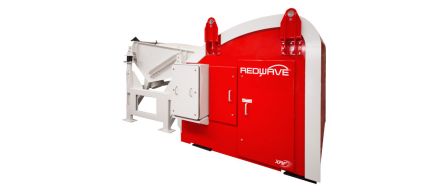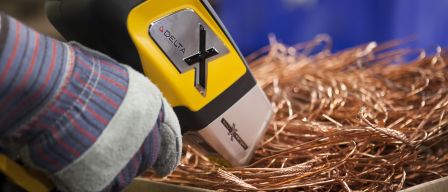Being able to separate wanted from unwanted material has always been the goal in the scrap recycling industry, and with good reason: knowing the type/quality of scrap coming into your yard prevents pricing errors; supplying the cleanest scrap to your customers saves them time and provides you with the most profit. High-quality separated materials produce the highest quality final product. If manufacturers, fabricators, smelting operations-your customers-feel confident that you can supply the material they want at the purity they need, you have created a win-win situation: they know they can rely on you, and you get a long-term customer. Scrap sorting has come a long way since the "watch for the color of the grinding spark" days. Today, large auto-shredding facilities and drive-in small batch yards have moved on to a more technological sorting process. Most scrap processors are familiar with Eddy Current separators (using magnets to separate ferrous metals from non-ferrous metals) and Optical Emission spectrometers (OES), also known as Arc / Spark (creating a spark that causes electrons to emit light waves). X-ray fluorescence, or XRF, is a fast, accurate, and relatively easy way to detect and separate the more difficult metal alloys and grades. Correct sorting allows you to accurately price the material coming into your yard, and to provide a purer scrap product to your customers. Over the past decade or so, XRF has been miniaturized into handheld "alloy analyzers", but is also available for on-line automated sorting of bulk material, for example in shredding operations. So whatever the size of your scrap operation, XRF sorting equipment has a place in it. | 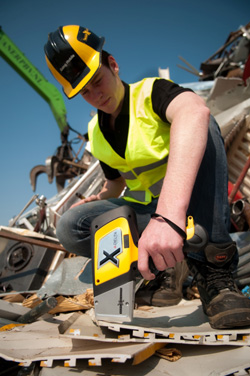 |
XRF Technique
Nearly all elements, from iron to copper to nickel to tungsten, have unique and known X-ray signatures. When an X- or Gamma-ray is absorbed by an element, the element fluoresces, or emits energy. Inner-shell atomic fluorescence produces the X-ray signature, and can be "captured" and reported.
XRF analyzers do both tasks: they provide the incident X-rays that generate the excitation in the atoms and then detect the fluorescence from most* of the elements in the sample material. Based on this, XRF equipment will also provide an analysis of which elements comprise the sample and at what percentages. Most will also provide grade identification, based on a comparison between the compositional analysis results and a grade specification library.
XRF detects multiple elements simultaneously, which makes it an excellent choice for sorting grades of stainless steel or aluminum, and separating glass streams.
*XRF can generally not detect and measure "lighter" elements such as carbon.
Sorting not just series, but grades of alloys
XRF has traditionally been used for basic stainless sorting, and nonferrous alloy grade separations, and with advances in the technology, it has moved onto more advanced detection.
Take Stainless grades 304 and 316. They look the same, they weigh approximately the same, and neither is magnetic. XRF can sort 304 from 316 because it can detect the approximately 2% molybdenum that's in the 316. That makes the price of 316 higher than 304 because molybdenum is a high-value element.
Stainless 304 and 347 both have-in addition to other elements-chromium and nickel, but they have different niobium content. XRF can detect each element's concentration and reliably sort the alloys in a test that takes less than one-second.
For light alloys, Handheld XRF has been typically limited for the separation of gross alloy series (for example, 2000 from 7000 series aluminum alloys). OES has traditionally been the portable technology of choice for sorting Al alloys. But with recent advances in handheld XRF alloy analyzers, they can now be used for more extensive grade separations within series.
A common wrought Aluminum alloy, 3003, is recognizable based on manganese (Mn) content. Sorting 3003 from other Al alloy series has been straight-forward for handheld XRF for years. With current Handheld XRF though, further separation of 3003 from 3004 and 3005, based on small amounts of magnesium (Mg) content-a light element just recently possible to analyze with good precision-is possible, at least with high-end handheld XRF.
But grade separation is not about just one element. Aluminum grades 6061 an 6063 have the same eleven elements and no others. The latest XRF alloy analyzers can discern one or the other based on the concentrations measured, with even a very short test.
Being able to sort and separate alloy grades, and examine materials for tramp residuals or poisons creates incremental value, happy customers and ultimately nice profits.
The hard stuff
On-line XRF automatically separates types of scrap that other technologies simply can't.
The three most popular scrap types that only XRF systems can separate in high speed sorting systems are: meatballs (electric motor alternators consisting of copper wire wound around iron cores), glass, and high-end nonferrous separation (i.e. grades of stainless steel and certain Aluminum grades.
Meatball Sorting
Meatballs cannot be efficiently separated out efficiently from shredded scrap streams by hand, eddy current or optical emission spectroscopy (OES). Since eddy current creates magnetism, the iron in the meatballs will be attracted to the magnet, along with every other piece of ferrous scrap. Optical emission sparking is too narrowly focused to detect all the metals in the meatball without multiple tests. The current method of separation, manual separation is slow, labor intensive, and prone to error.
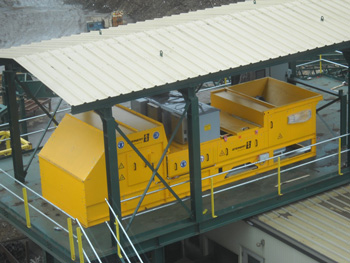
Automated XRF, however, works at the elemental level, and can simultaneously cover a broad testing area. It can quickly detect the copper in the meatballs in one fast pass, allowing immediate automatic sorting.
Glass Sorting
Ceramic glass-the kind used in cookware-cannot be mixed with standard glass if the cullet is to be recycled. Ceramic glass has a higher/different melting temperature than bottle/container glass (i.e, "regular glass). When new glass is made, if glass ceramic is mixed in it won't melt properly, which results in inclusions/defects in the new glass. Different melting temperatures can also cause issues in the glass production process, including damaging expensive production equipment.
Leaded glass, like from CRTs, crystal goblets, and chandeliers, offer the same problems as ceramic glass.
XRF can quickly and accurately detect these types of glass. Customers that have confidence in your ability to separate ceramic and leaded glass from standard glass will be your customer for a long time.
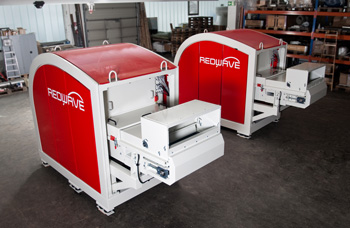
Colored glass gets its color from metals: cobalt for blue, iron for green, and sulfur or carbon for amber/brown. Recycled glass retains its color, so the cleaner the glass cullet you can supply, the truer the color of the final product.
Much of glass sorting is visual; is it blue, green, amber, or clear. But visual sorting is slow and error-prone. XRF sorting equipment can be calibrated to detect cobalt if the stream is a combination of clear glass mixed with blue, or it can be calibrated to detect any of the other metals to separate the other colors. Multiple XRF systems can be employed to: separate all colored glass from clear; blue from green and amber; and finally green from amber.
Aluminum Sorting
While it may be a simple weight or magnetic test to separate aluminum from other metals, determining the difference between types of aluminum has always been a challenge. All aluminum alloys are the same silver / grayish color, and all of them are lightweight. For example, 7000 series Aluminum alloys appear the same as 6000 series. Current recyclers are demanding an automated method fro separating these two alloys.
XRF can rapidly sort 7000 and 6000 series, as well as other series, and grades within those series.
How XRF can be used in recycling industry
XRF can be used in big recycling facilities and small, and for a range of scrap sorting needs.
Automobile shredding operations can incorporate XRF technology into existing sorters to refine separation, i.e., XRF analyzers added in series after an eddy current head can further separate ferrous items that also contain wanted (or unwanted) metals, and detect them in milliseconds.
Handheld XRF alloy analyzers can accompany you to demolition sites to determine the type of material that the site contains, allowing you to bid accurately (and more quickly than your competitors!).
Sorting and element detection with XRF is user configurable. Whatever changes in your scrap stream, XRF analyzer systems can be modified to adapt to the new need. An XRF analyzer that was being used to detect copper poison in low alloy steels in the morning can be used for fine sorting of aluminum alloys in the afternoon.
The current state of XRF technology can detect elements from Magnesium to Uranium, with ever improving sensitivities. As such, the breadth of material that is sort-able with this technology continues expanding.

